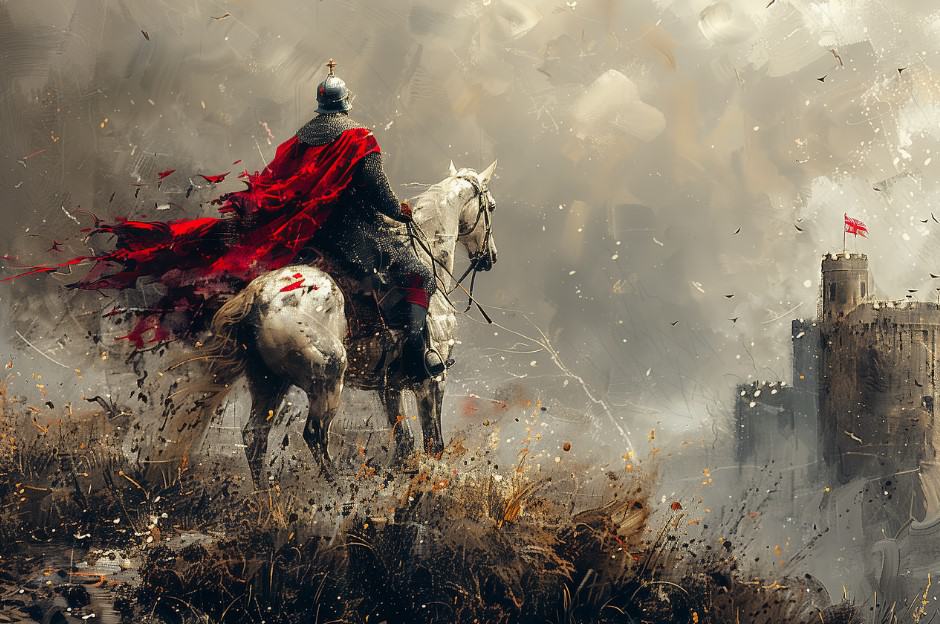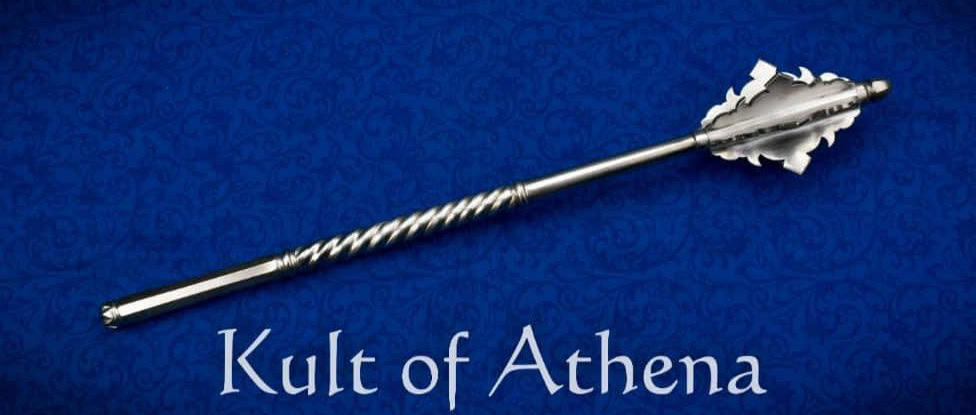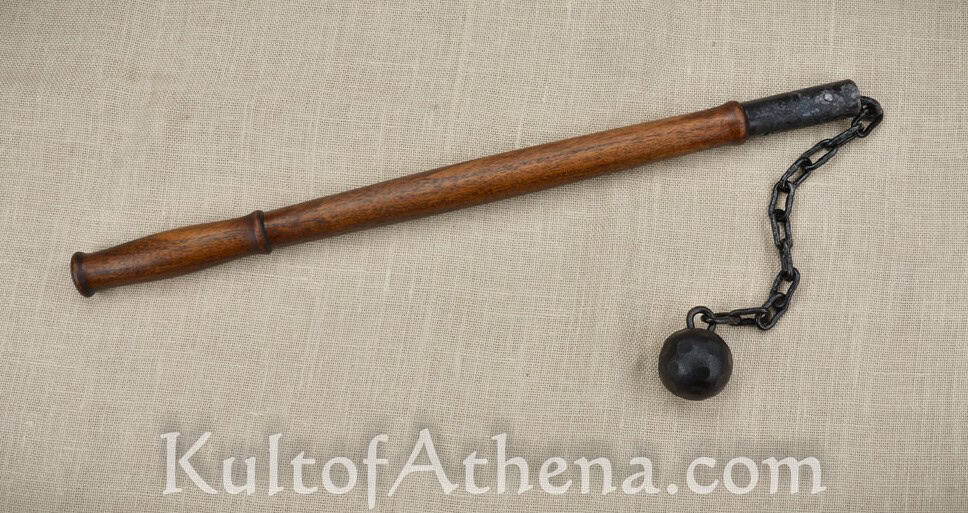Flail vs Mace
TLDR: The flail vs mace debate highlights the flail’s unpredictable whipping strikes and the mace’s reliable, controlled impact, each excelling in different combat scenarios.

When comparing medieval weapons, the flail and the mace often come up as two of the most iconic and intriguing. Both have their roots in the brutal, close-quarters combat of the Middle Ages, yet they offer distinct advantages and challenges. Understanding their differences not only sheds light on medieval warfare but also highlights the ingenuity of weapon design in that era.
| Feature | Flail | Mace |
| Structure | Flexible chain connecting handle to striking head | Rigid shaft with fixed striking head |
| Head attachment | Connected by chain or rope | Firmly attached to shaft |
| Striking motion | Whipping, unpredictable | Direct, more controlled |
| Impact force | Variable, potentially higher due to whipping motion | Consistent, direct transfer of force |
| Ease of use | More difficult to control | Easier to wield accurately |
| Risk to user | Higher risk of self-injury | Lower risk of self-injury |
| Armor penetration | Can potentially strike around shields or armor | Direct impact on armor |
| Use on horseback | More challenging and risky | Easier and safer to use |
| Manufacturing | More complex due to chain/linkage | Simpler construction |
| Historical prevalence | Less common, notable use by Hussites | More widely used across cultures |
Striking Mechanism
When it comes to the striking mechanism, the flail and mace couldn’t be more different, and that’s what makes this comparison so fascinating. Let’s start with the flail’s whipping motion. This unique feature is what sets it apart from pretty much every other medieval weapon. The chain allows the striking head to build up momentum, resulting in a powerful, unpredictable strike. I’ve always thought of it as the medieval equivalent of a curveball – you’re never quite sure where it’s going to land.
This unpredictability is both a blessing and a curse. On one hand, it makes the flail incredibly difficult to defend against. Even if you block the initial swing, the head can wrap around shields or weapons, potentially striking the defender from an unexpected angle. It’s this ability to bypass traditional defenses that, in my opinion, made the flail such a feared weapon on the battlefield.
On the flip side, the mace’s direct and controlled striking power offers a different set of advantages. With its rigid construction, every ounce of force applied by the wielder translates directly into the impact. There’s no energy lost in the flexibility of a chain. This makes the mace incredibly effective against armored opponents. I’ve always imagined that the sound of a mace striking plate armor must have been terrifying – a loud, resonating clang followed by the crumpling of metal.
When it comes to impact force, both weapons pack a serious punch, but in different ways. The flail, with its whipping motion, can potentially deliver more force at the point of impact due to the acceleration provided by the chain. However, this force is less consistent and harder to control. The mace, while potentially delivering less maximum force, provides a more consistent and reliable impact.
In terms of effectiveness, I believe both weapons excel in different scenarios. The flail shines in situations where unpredictability is an advantage, such as in chaotic melees or against heavily shielded opponents. Its potential to strike from odd angles makes it a wild card in combat.
The mace, however, is the go-to for reliability and armor penetration. Its consistent striking power makes it ideal for dealing with armored foes, and its simpler design means there’s less that can go wrong in the heat of battle. I’ve always thought of the mace as the dependable workhorse of medieval bludgeoning weapons.
Ease of Use
When it comes to ease of use, the flail and mace offer distinctly different experiences, each with its own set of challenges and advantages. The flail, with its flexible chain, requires a higher level of skill and finesse to wield effectively. Controlling the swinging head demands precise timing and coordination. I’ve always thought that mastering the flail must have felt like learning a complex dance – one misstep, and you could end up hitting yourself instead of your opponent.
The mace, on the other hand, is much more straightforward. Its rigid design means that what you see is what you get. The force you apply is directly transferred to the target, making it easier to predict and control. In my opinion, this makes the mace a more user-friendly weapon, especially for those who might not have the time or inclination to master the nuances of a flail.
However, the risks associated with using a flail are significant. The very flexibility that makes it so unpredictable in combat also makes it dangerous to the user. A poorly timed swing can result in the head rebounding and striking the wielder. This risk is compounded in the heat of battle, where split-second decisions can mean the difference between life and death. I imagine that using a flail required not just skill, but also a certain level of bravery – or perhaps recklessness.
In contrast, the mace’s rigid construction minimizes the risk of self-injury. Its straightforward design means there’s less that can go wrong. You swing, you hit, and the job gets done. This reliability is one of the reasons I think the mace was so popular among medieval warriors. It offered a dependable option in the chaos of combat.
When considering suitability for different combat scenarios, the flail and mace each have their niches. The flail’s ability to strike around shields and armor makes it particularly effective in close-quarters melee, where unpredictability can be a significant advantage. However, its complexity and the risk of self-injury make it less suitable for mounted combat. I imagine trying to control a flail while on horseback would be a nightmare – the added movement and lack of stable footing would make an already tricky weapon even harder to handle.
The mace, however, excels in both foot and mounted combat. Its ease of use and direct striking power make it a versatile weapon. Mounted knights, in particular, would have found the mace’s straightforward design advantageous. The ability to deliver powerful, controlled blows while riding at full speed is a testament to the mace’s effectiveness. I think this versatility is one of the reasons the mace remained a staple in medieval arsenals for so long.
Where Can I Get My Own Mace?
Finding a mace for your collection or historical reenactment can be a thrilling endeavor. Many online retailers and specialty shops offer a variety of maces, from historically accurate replicas to modern interpretations. Whether you’re looking for a functional piece for combat training or a decorative item, there are plenty of options to explore.
Kult of Athena

What I Like:
- Robust Construction: This Gothic Flanged Mace is built with a solid, all-steel design, offering the heft necessary to crush even the toughest armor.
- Gothic Styling: Its intricate gothic fluting and angular design make this mace a visually striking weapon, blending both form and function.
- Professional Craftsmanship: Crafted for knights and seasoned warriors, this mace delivers powerful blows with precision and durability.
Medieval Collectibles

What I Like:
- Decorative and Unique: This spiked mace, featuring a 23-inch length and a heavy hardwood handle, adds a striking touch to any medieval-themed event or display.
- Enhanced Grip and Durability: The handle, with its 1.75-inch diameter and hand grooves, ensures a tight, comfortable grip while the metal reinforcing bands enhance durability.
- Impressive Design: Equipped with 21 sharp metal spikes, this mace stands out as a dramatic stage prop or valuable addition to a medieval weapon collection.
Etsy – 3DCreationsNmore

Where Can I Get My Own Flail?
If you’re interested in owning a flail, you’re in luck. Various online stores and medieval weapon suppliers offer flails that cater to both enthusiasts and reenactors. You can find models ranging from historically inspired designs to more decorative pieces, ensuring that you can find the perfect addition to your collection or combat gear.
Kult of Athena

What I Like:
- Solid Steel Head: The Medieval Flail features a robust solid steel ball that delivers powerful concussive blows with great force and velocity.
- Reinforced Construction: The thick steel chain is securely welded and mounted to a hardwood haft, ensuring durability and readiness for action.
- Impressive Dimensions: With an overall length of 39 inches and a chain length of 12 inches, this flail is designed for impactful and decisive strikes.
Medieval Collectibles

What I Like:
- Stunning medieval replica: This Large Single Ball Medieval Flail is a striking decorative piece, perfectly capturing the essence of a 14th-century cavalry weapon.
- Handcrafted elegance: The hardwood handle is wrapped in leather cord and finished with a fringed leather cuff, adding an extra touch of authenticity and craftsmanship.
- High-quality materials: Featuring a gleaming iron spiked ball and a robust 27.5-inch length, this flail combines durability with an impressive historical design.
Final Thoughts
In comparing the flail vs mace, it’s clear that each weapon offers unique advantages and challenges, highlighting the ingenuity and diversity of medieval combat. The flail’s unpredictable, whip-like strikes make it a formidable and versatile weapon against shielded opponents, though its complexity and risk of self-injury require significant skill to master. On the other hand, the mace’s straightforward, reliable design and direct force transfer make it a favored choice for dealing with armored foes, offering consistency and ease of use in both foot and mounted combat. Personally, I find the balance between these two weapons fascinating – the flail’s wild, almost artistic chaos versus the mace’s dependable, brute force. While I appreciate the flail’s innovative design and its potential for surprising an opponent, I can’t help but admire the mace’s practicality and enduring popularity in medieval warfare, much like the variety found among the coolest weapons in history.
